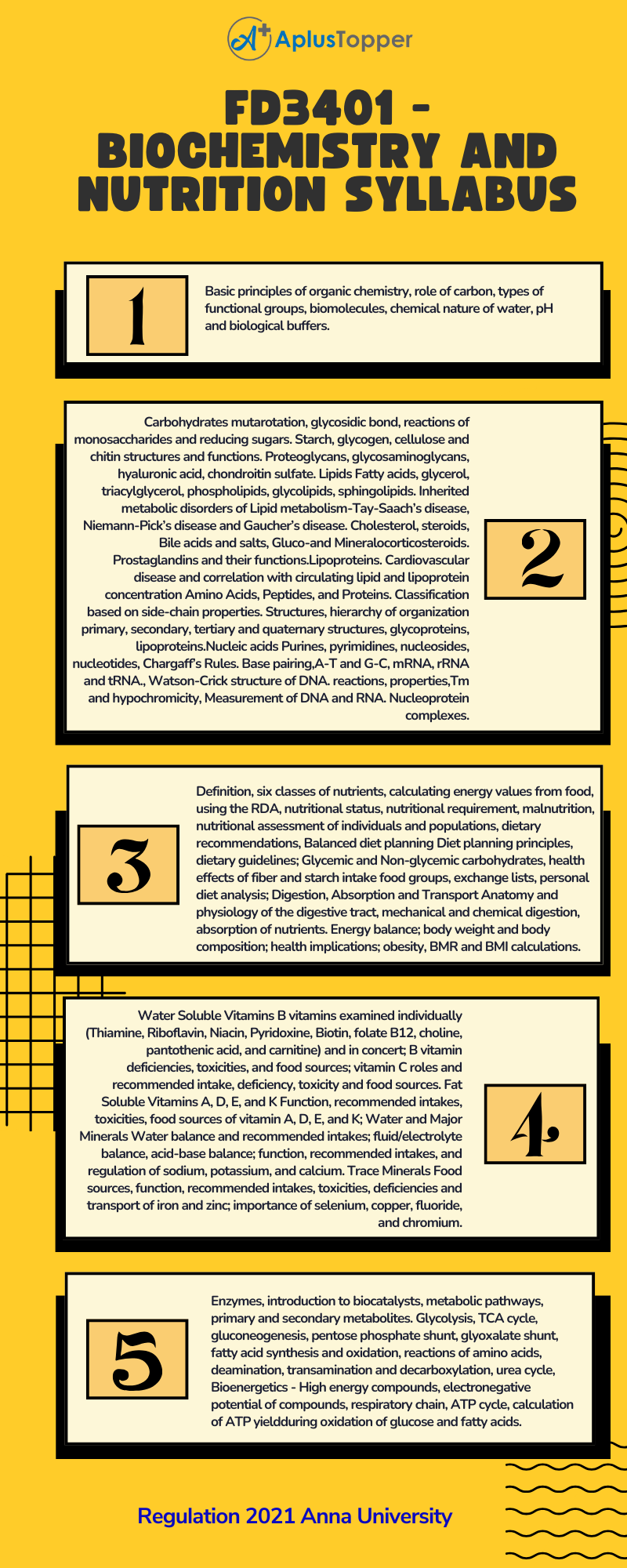FD3401 Subject code belongs to the Anna University, B.Tech Food Technology Semester IV syllabus. In this article, we discuss the syllabus of the Biochemistry And Nutrition subject. We hope it helps the students prepare for the academic exams.
The following article, FD3401 – Biochemistry And Nutrition Syllabus assists the students in thorough preparation for theory examinations. We include the detailed syllabus along with the expertise referred textbooks and references. Students can easily get information regarding the biochemistry and nutrition syllabus, we add every concept to each unit. You can follow the information and prepare well if you have any doubts regarding the syllabus of this subject. You can comment below. Aplustopper.com will be available as soon as possible. Hope this information is useful. Don’t forget to share this information with your classmates.
If you want to know more about the syllabus of B.Tech Food Technology Syllabus connected to an affiliated institution’s four-year undergraduate degree program. We provide you with a detailed Year-wise, semester-wise, and Subject-wise syllabus in the following link B.Tech Food Technology Syllabus Anna University, Regulation 2021.
Aim Of Objectives:
The course aims to
- Ensure students have a strong grounding in structures and reactions of biomolecules.
- Introduce them to metabolic pathway of the major biomolecules.
- Enable the students to understand roles of each nutrients in growth and metabolism.
FD3401 – Biochemistry And Nutrition Syllabus
Unit I: Introduction To Biomolecules
Basic principles of organic chemistry, role of carbon, types of functional groups, biomolecules, chemical nature of water, pH and biological buffers.
Unit II: Structure And Properties Of Important Biomolecules
Carbohydrates mutarotation, glycosidic bond, reactions of monosaccharides and reducing sugars. Starch, glycogen, cellulose and chitin structures and functions. Proteoglycans, glycosaminoglycans, hyaluronic acid, chondroitin sulfate. Lipids Fatty acids, glycerol, triacylglycerol, phospholipids, glycolipids, sphingolipids. Inherited metabolic disorders of Lipid metabolism-Tay-Saach’s disease, Niemann-Pick’s disease and Gaucher’s disease. Cholesterol, steroids, Bile acids and salts, Gluco-and Mineralocorticosteroids. Prostaglandins and their functions.Lipoproteins. Cardiovascular disease and correlation with circulating lipid and lipoprotein concentration Amino Acids, Peptides, and Proteins. Classification based on side-chain properties. Structures, hierarchy of organization primary, secondary, tertiary and quaternary structures, glycoproteins, lipoproteins.Nucleic acids Purines, pyrimidines, nucleosides, nucleotides, Chargaff’s Rules. Base pairing, A-T and G-C, mRNA, rRNA and tRNA., Watson-Crick structure of DNA. reactions, properties,Tm and hypochromicity, Measurement of DNA and RNA. Nucleoprotein complexes.

Unit III: An Overview Of Nutrition And Energy Balance
Definition, six classes of nutrients, calculating energy values from food, using the RDA, nutritional status, nutritional requirement, malnutrition, nutritional assessment of individuals and populations, dietary recommendations, Balanced diet planning Diet planning principles, dietary guidelines; Glycemic and Non-glycemic carbohydrates, health effects of fiber and starch intake food groups, exchange lists, personal diet analysis; Digestion, Absorption and Transport Anatomy and physiology of the digestive tract, mechanical and chemical digestion, absorption of nutrients. Energy balance; body weight and body composition; health implications; obesity, BMR and BMI calculations.
Unit IV: Vitamins And Minerals
Water Soluble Vitamins B vitamins examined individually (Thiamine, Riboflavin, Niacin, Pyridoxine, Biotin, folate B12, choline, pantothenic acid, and carnitine) and in concert; B vitamin deficiencies, toxicities, and food sources; vitamin C roles and recommended intake, deficiency, toxicity and food sources. Fat Soluble Vitamins A, D, E, and K Function, recommended intakes, toxicities, food sources of vitamin A, D, E, and K; Water and Major Minerals Water balance and recommended intakes; fluid/electrolyte balance, acid-base balance; function, recommended intakes, and regulation of sodium, potassium, and calcium. Trace Minerals Food sources, function, recommended intakes, toxicities, deficiencies and transport of iron and zinc; importance of selenium, copper, fluoride, and chromium.
Unit V: Intermediary Metabolism And Regulation
Enzymes, introduction to biocatalysts, metabolic pathways, primary and secondary metabolites. Glycolysis, TCA cycle, gluconeogenesis, pentose phosphate shunt, glyoxalate shunt, fatty acid synthesis and oxidation, reactions of amino acids, deamination, transamination and decarboxylation, urea cycle, Bioenergetics – High energy compounds, electronegative potential of compounds, respiratory chain, ATP cycle, calculation of ATP yield during oxidation of glucose and fatty acids.
Text Books:
- Nelson, D.L. and M.M. Cox, “Lehninger’s Principles of Biochemistry”, 4th Edition, W.H. Freemen & Co., 2005.
- Satyanarayana, U. and U. Chakerapani, “Biochemistry” 3rd Rev. Edition, Books & Allied (P) Ltd., 2006.
- Rastogi, S.C. “Biochemistry” 2nd Edition, Tata McGraw-Hill, 2003.
- Mann, Jim and Stewart Truswell “Essentials of Human Nutrition”. 3rd Edition. Oxford University Press, 2007.
- Gibney, Michael J., et al., “Introduction to Human Nutrition”. 2nd Edition. Blackwell, 2009.
References:
- Berg, Jeremy M. et al. “Biochemistry”, 6th Edition, W.H. Freeman & Co., 2006.
- Voet, D. and Voet, J.G., “Biochemistry”, 3rd Edition, John Wiley & Sons Inc.,2004.
- Gropper, Sareen S. and Jack L. Smith “Advanced Nutrition and Human Metabolism”. 5th Edition. Wadsworth Publishing, 2008.
Related Posts On Semester – IV:
Must Read:
